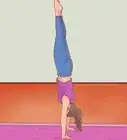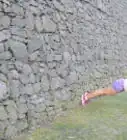This article was co-authored by Rosalind Lutsky, a trusted member of wikiHow's volunteer community. Rosalind Lutsky worked as a gymnastics coach at SB Gymnastics at Stanford University, coaching children from ages 5-12 years old during her time as a Stanford student. She was a competitive gymnast growing up, and competed for her local gymnastics team in Minnesota.
wikiHow marks an article as reader-approved once it receives enough positive feedback. In this case, 86% of readers who voted found the article helpful, earning it our reader-approved status.
This article has been viewed 77,341 times.
Learn more...
A kip is an intermediate-level gymnastics move that is primarily a way to mount the high or low bar or to move from one bar to the other. Both men's and women's gymnastics use the kip, but they are done on slightly different equipment for each. Kipping is an essential skill for gymnasts, especially for gymnasts who compete in bar routines.
Steps
Learning to Glide Swing
-
1Stand up to three feet away from the low bar. You may stand flat on the ground, or you may use a springboard.[1]
- Standing too far away may cause you to miss the bar when you jump for it.
- If you jump from the ground, you will have to jump equally up and forward to catch the bar. If you jump from a springboard, you will likely only have to focus more on moving forward in your jump.
-
2Bend your knees slightly and hold your arms out in front of you to prepare for the jump. Your bent knees prepare you to make the jump, while your outstretched arms will enable you to quickly and easily catch the bar.
- Line your hands up with the height of the bar in order to more easily catch it.
- Keep your feet flat on the floor or springboard.
Advertisement -
3Push forward from the slightly crouched position to jump for the bar. Keep your arms outstretched in front of you to grab the bar.
- Your arms will likely need to be higher above your head if you are jumping from the ground. On the other hand, if you are jumping from a springboard, you will be able to keep your hands in front of you, rather than above you.
- A small jump is required, just enough to give you momentum to get to the bar and start your glide swing. Too much force in your jump will cause you to rise above the low bar and may set your kip off to a messy start.
-
4Grab the bar and begin to glide your body below it. Hang from the bar once you grab it, allowing your body to swing below it.[2]
- You may choose to keep your legs together in a pike for your glide swing. If so, keep your body slightly bent at the hips so that your feet do not hit the floor.
- Another option is to spread your legs into a straddle position. If you choose this position, you can keep your body straight, as your legs will be lifted high enough from the floor.
-
5Glide below the bar until your body extends on the other side of it. Maintain your pike or straddle position with your legs until you reach the other side of the bar.[3]
- Your arms should be extended straight once you swing to the other side of the bar.
EXPERT TIPRosalind Lutsky worked as a gymnastics coach at SB Gymnastics at Stanford University, coaching children from ages 5-12 years old during her time as a Stanford student. She was a competitive gymnast growing up, and competed for her local gymnastics team in Minnesota.Former Gymnastics Coach
 Rosalind Lutsky
Rosalind Lutsky
Former Gymnastics CoachRosalind Lutsky, former gymnastics coach, adds: “It’s good practice to try to keep your legs straight and together as you go. Have someone spot you as you practice the next stage, so you can keep the proper form in tact.”
-
6Thrust your hips forward and straighten your whole body. As you end the glide swing, you are preparing your body to transition into the next move, which is the pike-up.
- If you completed your glide swing with straddled legs, bring them together in a pike position as you thrust your hips forward.
- If you did the glide swing in a pike, then straighten out your hips so that your body flattens.
Learning to Pike-Up
-
1Scoop your stomach at the peak of the glide swing. The peak of the glide swing is the moment when your body stops moving forward and begins to swing back.
- You are preparing to fold your body for the pike-up, so pulling your stomach back into a scooped position makes it easier to pull your legs up.
-
2Lift your feet toward the bar. As your body swings back, quickly lift your feet so that they point upward.[4]
- Your torso should be about parallel to the floor when you do your pike-up so that your hips are bent at about a 90-degree angle.
- Keep your legs together in a pike position while you lift them upward.
-
3Bring the tip of your toes to the bar. At the end of your pike-up, your toes should touch the bar.[5]
- This is the end of the pike-up, so from this position, you will finish the kip with a pull-up.
- Remember to keep your legs and feet squeezed together in the pike position to maintain speed and safety.
Learning to Pull Up
-
1Swing backward from the peak of the pike-up. Allow your body to follow the natural swing backward, and keep your arms straight while you do so.
- Keep your body tucked close to the bar while you swing, though, to easily pull yourself up later. Specifically, you need to keep your hips close to the bar.
- Imagine this as rocking backward under the bar. Your head should rise higher on the other side of the bar as you swing back, while your legs come down.
-
2Drop your legs while your body swings back. This puts your body back in a full pike position, enabling you to pull-up when you reach the other side of the bar again.
- Allow the momentum of dropping your legs to push your body upward. This will help you as you start to pull up.
-
3Pull your body upward above the bar. You will almost rotate your hips around the bar to pull yourself up, which is why it is so essential in earlier steps to keep your hips close to the bar.
- Your legs will likely swing back and away from the bar as you pull yourself up. Maintain the pike but allow them to swing, because they are simply following the momentum of the natural movement. This also prepares you for the next step.
EXPERT TIPRosalind Lutsky worked as a gymnastics coach at SB Gymnastics at Stanford University, coaching children from ages 5-12 years old during her time as a Stanford student. She was a competitive gymnast growing up, and competed for her local gymnastics team in Minnesota.Former Gymnastics Coach
 Rosalind Lutsky
Rosalind Lutsky
Former Gymnastics CoachRosalind Lutsky, former gymnastics coach, notes: "If you're having trouble pulling your toes up to the bar or pulling yourself over the bar during the kip, it can be helpful to practice some core strengthening exercises.”
-
4Flick your wrists over the bar once your torso is above it. This allows you to hold yourself above the bar without losing your grip.[6]
- You may have to shift your hands just a bit to get them into this stronger hold, but do not let go of the bar.
-
5Allow your legs to hang straight down from the bar while holding your torso upright. This is the end of the kip, and from this position, you can continue on with your bar routine.[7]
- Keep your abdominal muscles contracted to help hold your position.
- Your hips should rest on the bar, while your arms are straight and you look forward ahead of you.
Community Q&A
-
QuestionHow do I prevent tapping on the other side?
 Community AnswerDo some abs work outs like v snaps, tuck snaps, straddle snaps, sit ups. Hold you feet to the bar for 1 minute and do lots of kips. Try your hardest to keep your feet up. Don't give up.
Community AnswerDo some abs work outs like v snaps, tuck snaps, straddle snaps, sit ups. Hold you feet to the bar for 1 minute and do lots of kips. Try your hardest to keep your feet up. Don't give up. -
QuestionAre there any ways to practice flicking your wrist to get on the bar?
 Matheson LupoCommunity AnswerGet a pbc pipe, a heavy stuffed animal and some string/yarn. Tie the stuffed animal to the string and then the end of the string to the pipe. Then, put your arms out straight and shift your wrists.
Matheson LupoCommunity AnswerGet a pbc pipe, a heavy stuffed animal and some string/yarn. Tie the stuffed animal to the string and then the end of the string to the pipe. Then, put your arms out straight and shift your wrists. -
QuestionI'm a level 4 gymnast. I arch my back when I do my kip, and I can't stop. How do I fix this?
 Community AnswerTry getting someone to spot you and straighten your back. Once you think you can do it without an arched back, try it on your own. Remember, practice makes perfect. Don't forget that! You will get there in the end.
Community AnswerTry getting someone to spot you and straighten your back. Once you think you can do it without an arched back, try it on your own. Remember, practice makes perfect. Don't forget that! You will get there in the end.
Warnings
- Have a trained gymnastics coach present with you while you learn and practice kipping. He or she will need to spot you and assist you with the different components until you master it.⧼thumbs_response⧽
References
- ↑ https://www.youtube.com/watch?v=qYXei2pRsIg
- ↑ https://usagym.org/pages/home/publications/technique/2004/10/glide_kip.pdf
- ↑ https://usagym.org/pages/home/publications/technique/2004/10/glide_kip.pdf
- ↑ https://www.youtube.com/watch?v=ZbmLgngEtPc
- ↑ https://www.youtube.com/watch?v=ZbmLgngEtPc
- ↑ https://www.youtube.com/watch?v=qYXei2pRsIg
- ↑ https://www.youtube.com/watch?v=LIEHKcZIjiI
- ↑ http://www.wired.com/2011/03/physics-of-the-kip/
About This Article
To do a kip, start by doing a glide swing on a gymnastics bar and straightening out your body. Then, when you start to swing back under the bar, lift your legs so that your feet are pointing upward and your torso is nearly parallel to the floor. Once your toes are touching the bar, allow your body to continue swinging back, keeping your hips close to the bar. As you're swinging back, drop your legs and then pull your body up above the bar. Finally, flick your wrists over the bar and bring your legs up so your body is parallel to the floor. To learn how to do a glide swing, keep reading!
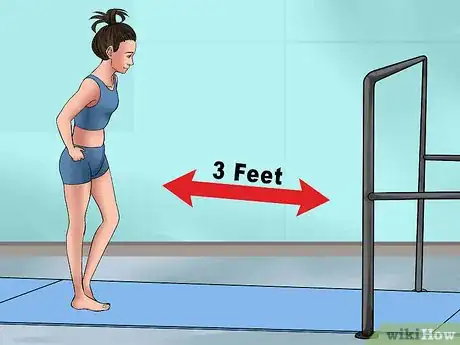

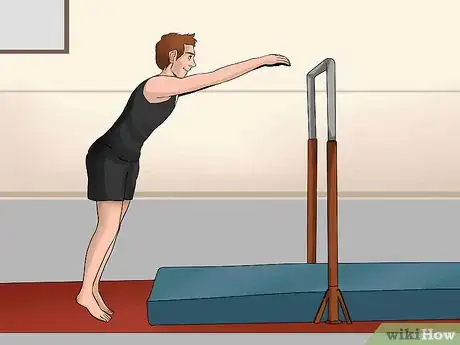


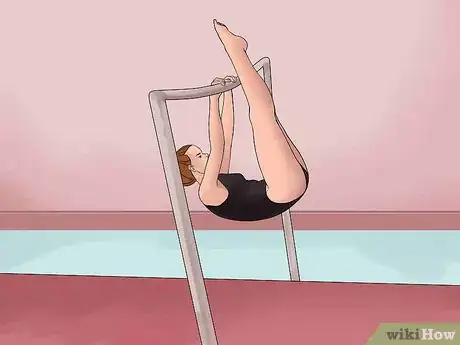
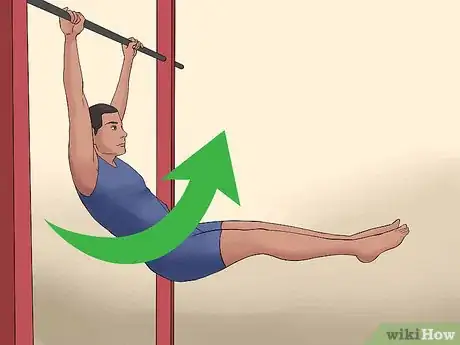




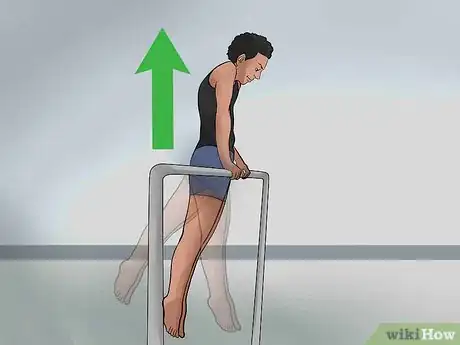



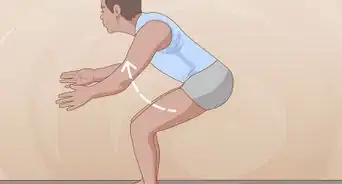



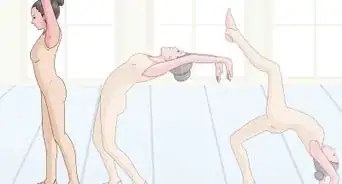
-Step-6-Version-4.webp)









